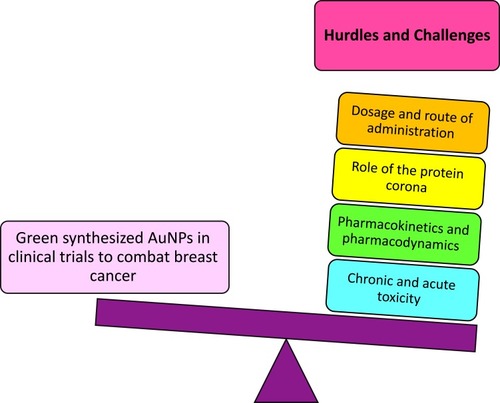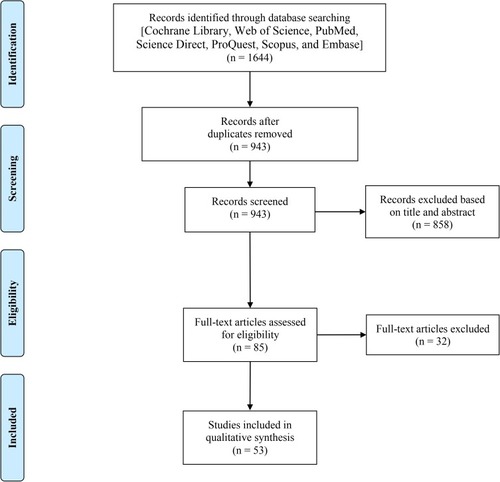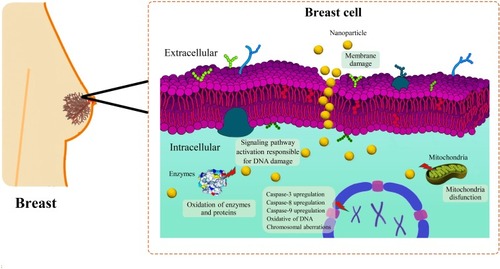Figures & data
Table 1 The Results of Anticancer Activity of Biosynthesized AuNPs Against Breast Cancer Cells
Figure 2 Schematic visualization of reduction and stabilization of AuNPs using different natural sources. (A) Schematic visualization of reduction and stabilization of AuNPs using different fruit extracts. Reprinted from J Saudi Chem Soc. Vol 23. Vijayakumar S. Eco-friendly synthesis of gold nanoparticles using fruit extracts and in vitro anticancer studies, pages 753-761, Copyright 2019, with permission from Elsevier.Citation53 (B) Synthetic outline for the isolation of mangiferin and synthesis of AuNPs. Reprinted from Mater Sc Eng C. Vol 90. Patra N, Dehury N, Pal A, Behera A, Patra S. Preparation and mechanistic aspect of natural xanthone functionalized gold nanoparticle, pages 439–445, Copyright 2018, with permission from Elsevier.Citation56 (C) Biosynthesis of AuNPs from Dragon fruit extract (DF extract) can be considered as an eco-friendly alternative for synthesis of AuNPs. Reprinted from Mater Lett. Vol 236. Divakaran D, Lakkakula JR, Thakur M, Kumawat MK, Srivastava R. Dragon fruit extract capped gold nanoparticles: synthesis and their differential cytotoxicity effect on breast cancer cells, pages 498–502, Copyright 2019, with permission from Elsevier.Citation51 (D) One pot green synthesize of AuNPs were achieved using the leaf extracts of Carica papaya (CP) and Catharanthus roseus (CR) and the combination of these two extracts (CPCRM). Reprinted from Process Biochem. Vol 51. Muthukumar T, Sudhakumari SB, Aravinthan A, Sastry TP, Kim JH. Green synthesis of gold nanoparticles and their enhanced synergistic antitumor activity using HepG2 and MCF7 cells and its antibacterial effects, pages 384–391, Copyright 2016, with permission from Elsevier.Citation76 (E) Pectin, an anionic polysaccharide isolated from Musa paradisiaca is employed for the synthesis of AuNPs at ambient temperature conditions. Reprinted from Int J Biol Macromol. Vol 93. Suganya KSU, Govindaraju K, Kumar VG, Karthick V, Parthasarathy K. Pectin mediated gold nanoparticles induces apoptosisin mammary adenocarcinoma cell lines, pages 1030–1040, Copyright 2016, with permission from Elsevier.Citation75 (F) Green synthesis of AuNPs from Anacardium occidental leaves extract. The colour change from gold to ruby red indicates the formation of AuNPs. Reprinted from Saudi J Biol Sci. Vol 26. Sunderam V, Thiyagarajan D, Lawrence AV, Mohammed SSS, Selvaraj A. In-vitro antimicrobial and anticancer properties ofgreen synthesized gold nanoparticles using Anacardium occidentale leaves extract, pages 455–459, Copyright 2019, with permission from Elsevier.Citation47
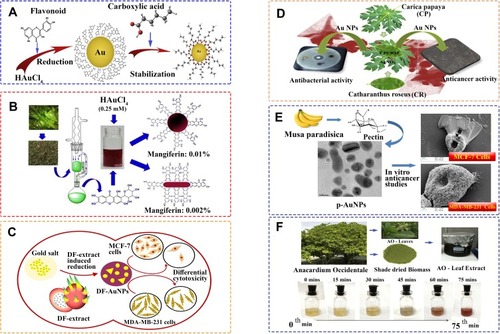
Figure 3 Schematic illustration of AuNPs for drug delivery systems. (A) Schematic illustration of hybrid AuNP coated by DNA, followed by the loading of positively charged drugs and then PEGylation for combination therapy of cancer. Reprinted from J Controlled Release. Vol 219. He C, Lu J, Lin W. Hybrid nanoparticles for combination therapy of cancer, pages 224–236, Copyright 2015, with permission from Elsevier.Citation100 (B) Schematic illustration of different applications of AuNPs in diagnosis and therapy. AuNPs are used in a variety of contexts such as: photo thermal therapy, targeting, drug delivery, imaging, nucleic acid delivery, toxin and microbial agent removal and as an adjuvant. Reprinted from Adv Drug Delivery Rev. Vol 60. Ghosh P, Han G, De M, Kim CK, Rotello VM. Gold nanoparticles in delivery applications, pages 1307-15, Copyright 2008, with permission from Elsevier.Citation101 (C) Schematic representation of synthesis of biogenic AuNPs and subsequent conjugation of doxorubicin. Biodegradable doxorubicin-loaded biogenic AuNPs complexes can be easily fragmented to release doxorubicin from AuNPs. Diffusion and accumulation of doxorubicin into cell nucleus could be achievable regardless of the size of AuNP used. Reprinted from Colloids Surf B Biointerfaces. Vol 135. Seo JM, Kim EB, Hyun MS, Kim BB, Park TJ. Self-assembly of biogenic gold nanoparticles and their use to enhance drug delivery into cells, pages 27–34, Copyright 2015, with permission from Elsevier.Citation102 (D) Schematic diagram of epirubicin-loaded marine carrageenan oligosaccharide capped AuNPs for anticancer drug (epirubicin) delivery to combat cancer cells. Reprinted from Sci Rep. Vol 9. Chen X, Han W, Zhao X, Tang W, Wang F. Epirubicin-loaded marine carrageenan oligosaccharide capped gold nanoparticle system for pH-triggered anticancer drug release, pages 6754, Copyright 2019, Under the terms of the Creative Commons CC BY license, Springer Nature.Citation103
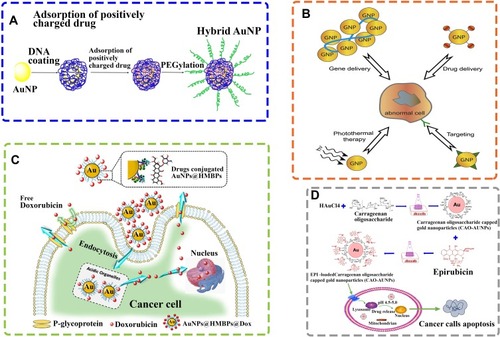
Figure 5 Hurdles and challenges of scientists before biogenic AuNPs enter clinical trials to combat breast cancer.
